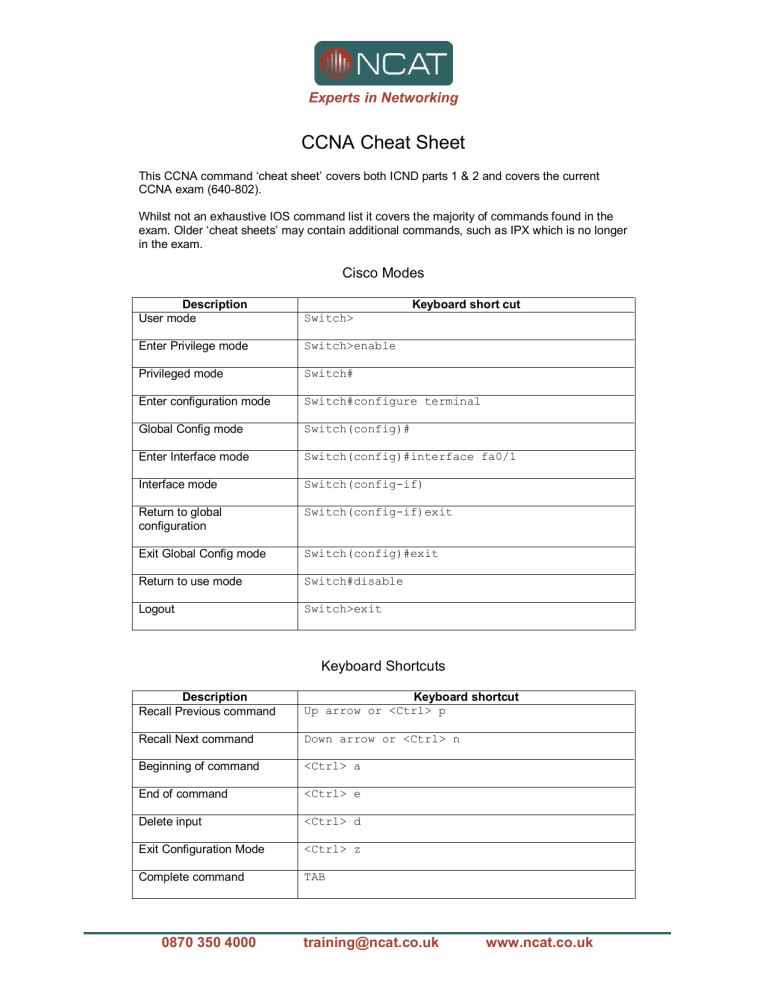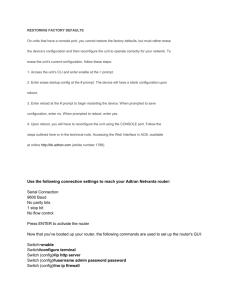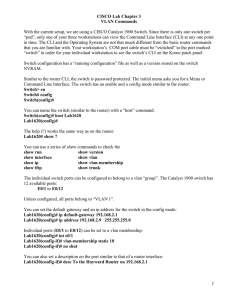
Experts in Networking CCNA Cheat Sheet This CCNA command ‘cheat sheet’ covers both ICND parts 1 & 2 and covers the current CCNA exam (640-802). Whilst not an exhaustive IOS command list it covers the majority of commands found in the exam. Older ‘cheat sheets’ may contain additional commands, such as IPX which is no longer in the exam. Cisco Modes Description User mode Switch> Keyboard short cut Enter Privilege mode Switch>enable Privileged mode Switch# Enter configuration mode Switch#configure terminal Global Config mode Switch(config)# Enter Interface mode Switch(config)#interface fa0/1 Interface mode Switch(config-if) Return to global configuration Switch(config-if)exit Exit Global Config mode Switch(config)#exit Return to use mode Switch#disable Logout Switch>exit Keyboard Shortcuts Description Recall Previous command Keyboard shortcut Up arrow or <Ctrl> p Recall Next command Down arrow or <Ctrl> n Beginning of command <Ctrl> a End of command <Ctrl> e Delete input <Ctrl> d Exit Configuration Mode <Ctrl> z Complete command TAB 0870 350 4000 training@ncat.co.uk www.ncat.co.uk Experts in Networking Device Configuration Description Configure device system name Commands Switch(config)#hostname sw1 Sets the encrypted enable password Switch(config)#enable secret cisco Sets the unencrypted enable password Switch(config)#enable password cisco Enable password encryption on all clear text password within the configuration file Switch(config)#service password-encryption Configure a Message Of The Banner, with an ending character of $ Switch(config)#banner motd $ Assign IP address to vlan Switch(config)#int vlan 1 Switch(config-if)#ip addr 172.22.1.11 255.255.255.0 Assign Default gateway, note the mode Switch(config)#ip default-gateway 10.1.1.1 Select one interface Switch(config)#int fa0/1 Select a range of interfaces (version dependant) Switch(config)#int range fa0/1 – 12 Set the interface description Switch(config-if)#description Add vlan using config mode switch(config)#vlan 11 switch(config-vlan)#name test Configure Interface fa0/1 @ speed 100 Mbps and full duplex Switch(config-if)#speed 100 Switch(config-if)#duplex full Assign interface to vlan switch(config-if)#switchport access vlan 11 Enable Port Security. Switch(config-if)#switchport mode access Switch(config-if)#switchport port-security Switch(config-if)#switchport port-security mac-address sticky Disable Interface Switch(config-if)shutdown Enable Interface Switch(config-if)no shutdown 0870 350 4000 training@ncat.co.uk www.ncat.co.uk Experts in Networking Configures 5 Telnet sessions each with a password of ‘cisco’ Switch(config)#line vty 0 4 Switch(config-line)#login Switch(config-line)#password cisco Enable and define console password of ‘cisco’ Switch(config)#line con 0 Switch(config-line)#login Switch(config-line)#password cisco Synchronise console messages (keep what you have typing on the screen) Switch(config-line)#logging synchronous Set the timezone and automatically adjust Switch(config)#clock timezone gmt 0 Switch(config)#clock summer-time gmt recurring Sets the switch priority for the vlan. This combined with the switch mac address creates the switch BID Switch(config)#spanning-tree vlan 1 priority 4096 Enables portfast Switch(config)#int fa0/1 Switch(config-if)#spanning-tree portfast Enables RSTP. Other options are, PVST and MST Switch(config)#spanning-tree mode rapid-pvst Creates a vlan. Note this now done in config mode not vlan database. Also note the ‘int vlan’ command does NOT create vlans Switch(config)#vlan 2 Switch(config-vlan)#name sales Assign an interface to vlan 2 Switch(config-if)#switchport access vlan 2 Unconditionally forces an interface into trunking. Other options are access and dynamic Switch(config-if)#switchport mode trunk Manually assign a switch to a VTP domain. A switch will automatically become part of a VTP domain if it’s currently in the ‘null’ domain and receives a VTP frame Switch(config)#vtp domain lab Changes the VTP mode from the default ‘server’ mode to client mode. In client mode no changes can be made Switch(config)#vtp mode client Enable the http server to SDM can be used Router(config)#ip http server 0870 350 4000 training@ncat.co.uk www.ncat.co.uk Experts in Networking Defines a username and password. The list can be used for many things from PPP authentication to user access Router(config)#username sue password cisco Defines a local host file. Like /etc/hosts in unix Router(config)#ip host mypc 10.1.1.3 Disables DNS lookup. Useful when a command as been miss typed Router(config)#no ip domain-lookup Sets the logical (not physical) bandwidth of interface. This is used by routing protocols, SNMP queuing etc Router(config)#int s0 Router(config-if)#bandwidth Sets the physical clock Router(config-if)#clock rate 64000 Set the serial interface WAN encapsulation. Other options are PPP or frame-relay Router(config-if)#encapsulation hdlc Authentication on PPP is optional. This command enable chap on the interface. Other option PAP Router(config-if)#ppp authentication chap Defines the type of LMI being used. If left unconfigured the correct LMI type should be automatically detected Router(config-if)#frame-relay lmi-type cisco Defines a static route. Renumber static routes have an admin distance of 1. Therefore will over ride any dynamic routing. Router(config)#ip route 50.0.0.0 255.0.0.0 10.1.2.1 Enables RIP version 1 on all LOCAL interfaces which have a 10.x.x.x address Router(config)#router rip Router(config-router)#network 10.0.0.0 Enables RIP version 2 Enable the router to provide a DHCP service. Router(config-router)#version 2 Router(config)#ip dhcp pool MYPOOL Router(dhcp-config)#network 10.1.1.0 255.255.255.0 Router(dhcp-config)#default-router 10.1.1.1 Router(dhcp-config)#exit Router(config)#ip dhcp excluded-address 10.1.1.1 10.1.1.99 Router(config)#config-register 0x2102 Changes the config register which controls what the 0870 350 4000 training@ncat.co.uk www.ncat.co.uk Experts in Networking router does when the router boots Creates a logical sub interface below the physical interface Router(config)#int fa0/0.1 Enables 802.1q trunking on the interface Router(config-subif)#encapsulation dot1Q 1 Define the ip address Router(config-subif)#ip address 10.1.1.1 255.255.255.0 Router(config-)#router ospf 1 Router(config-router)#network 10.1.0.0 0.0.255.255 area 0 Enable OSPF on any local interface which start with the ip address 10.1.x.x. Note the inverted mask EIGRP can be configured in a similar way to RIP or the mask option could be used Defines a standard ACL. Standard ACL use number 1-99 Router(config)#router eigrp 1 Router(config-router)#network 172.16.0.0 Or Router(config-router)#network 172.16.2.0 0.0.0.255 Router(config)#access-list 1 permit 172.16.1.1 Defines an Extended ACL. The first address is the source IP address Router(config)#access-list 101 deny tcp host 172.16.1.1 host 172.16.2.1 eq telnet Router(config)#access-list 101 permit ip any any Use the group command to attach an ACL to an interface. is used under an interface if the ACL is to filter traffic Router(config)#interface fa0/0 Router(config-if)#ip access-group 1 out An example using named ACL in stead of numbers Router(config)#ip access-list extended my_list Router(config-ext-nacl)# deny tcp host 172.16.1.1 host 172.16.2.1 eq ftp Router(config-ext-nacl)# permit ip any any Attaching a named ACL to an interface Router(config)#int fa0/0 Router(config-if)#ip access-group my_list in Configuring a static NAT to allow a server to be access via the Internet, using the IP address on interface s0/0/1 Router(config)#ip nat inside source static 10.1.1.2 interface s0/0/1 Defining interface which NAT takes place between Router(config)#int fa0/0.1 Router(config-if)#ip nat inside Enables RIPng Router(config)#ipv6 unicast-routing ROuter(config)#ipv6 router rip ccna 0870 350 4000 training@ncat.co.uk www.ncat.co.uk Experts in Networking Router(config)#int s0/0/0 Router(config-if)#ipv6 rip ccna enable Privilege Commands Description Manually starts the setup dialog which is automatically invoked when the device starts with no config Commands Switch#setup Displays the config held in DRAM. Which is lost if not copy run start command is not used Switch#show running-config Displays the NVRAM (None volatile) config. Switch#show startup-config Saves the config. Without this command all changes/configuration will be lost. Switch#copy running-config startup-config Saves the running config to a TFTP server Switch#copy running-config tftp Copies IOS files to a TFTP server Switch#copy flash tftp Copies files from a TFTP server the device flash Switch#copy tftp flash Erase the config held in NVRAM. If this is followed with the reload command all configuration is lost Switch#erase startup-config Reboots the device Switch#reload Abort sequence <Shift> <Ctrl> 6 Suspend Telnet Session <Shift> <Ctrl> 6(then let all keys go, then)x Show the current sessions. The one with a * is your active session Switch#show sessions Forcible closes a telnet session Switch#disconnect Set the device local clock. Note this is not done in config mode Switch#clock set 10:00:00 april 2 2008 0870 350 4000 training@ncat.co.uk www.ncat.co.uk Experts in Networking Display the IOS version along with other useful info e.g sys uptime, config register etc Switch#show version Displays the file contents of the flash Switch#show flash Displays the clock Switch#show clock Displays the users currently logged on Switch#show users By default displays the last 10 commands Switch#show history Displays the ARP cache Switch#show arp Displays the spanning tree status on vlan 1 Switch#show spanning-tree vlan 1 Lists all the configured vlans Switch#show vlan Displays VTP info such as VTP mode, VTP domain, VTP counter. Switch#sh vtp status Ping selected address Switch#ping 10.1.1.1 Extended ping. Must be in privilege mode Switch#ping Display the interface status Switch#show int fa0/1 Displays the vlan status and the IP address VLAN 1 (often the management vlan) Switch#show interfaces vlan 1 Displays a list of CDP neighbours Switch#show cdp neighbors Extended information on the above Switch#show cdp neighbors details Display CDP packets as they arrive Switch#debug cdp packets Display ping packets as they arrive Switch#debug icmp packets Display switch MAC Addresses table. These entries are learnt from the source mac address in the Ethernet frames Switch#show mac address-table 0870 350 4000 training@ncat.co.uk www.ncat.co.uk Experts in Networking Displays the interface operational status and IP addresses for all router interfaces Router#show ip interface brief Displays all the configured routing protocols Router#show ip protocols Displays the IP routeing table Router#show ip route Displays the NAT translations Router#show ip nat translations Displays the physical cable DTE/DCE, x.21, V.35, RS232 configuration Router#show controllers s 0 Displays the end-to-end status. Recall that ‘show interface’ does not Router#show frame-relay pvc Displays the type of LMI and the number LMI frames Router#show frame-relay lmi Displays the frame relay inverse ARP table Router#show frame-relay map To be come neighbours both the local and remote interface must be correctly configured. Router#show ip ospf neighbor If adjacent routers don’t become neighbours. Then use the command to check the local router interface is configured correctly Router#show ip ospf interface Same information as the above OSPF commands but with EIGRP. Remember that AS numbers MUST match Router#show ip eigrp neighbor Same information as the above OSPF commands but with EIGRP Router#show ip eigrp interface IPv6 ping. Recall that :: means all zero in between Router#ping 2000:1000:500:3::1 0870 350 4000 training@ncat.co.uk www.ncat.co.uk


